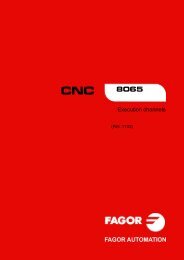4 - Fagor Automation
4 - Fagor Automation
4 - Fagor Automation
You also want an ePaper? Increase the reach of your titles
YUMPU automatically turns print PDFs into web optimized ePapers that Google loves.
4.<br />
CANNED CYCLES OF THE EDITOR<br />
CNC 8065<br />
(REF: 1209)<br />
·154·<br />
'3D profile pocket with islands.<br />
4.16.1 Executable pocket file<br />
i<br />
Canned cycles (·M· model)<br />
To simulate or execute this type of pockets, the CNC uses an executable file with geometry<br />
information. This file is generated the first time the pocket is simulated or executed. If from<br />
the editor, any data of the pocket geometry or the used tool, is modified, the CNC will generate<br />
this file again.<br />
In versions prior to V2.00, the user generated the executable file from the editor before inserting the<br />
cycle. From version V2.00 on, it is no longer necessary, the CNC is in charge of generating the<br />
executable file when necessary.<br />
The executable files are stored in the directory CNC8070 \Users \Pocket with the name of<br />
the pocket (parameter P.3D) and the extension C3D. These files must not be deleted, moved<br />
to another location or tampered with in any way. If when executing or simulating the pocket,<br />
the CNC cannot find these files, it will generate them.<br />
Overall, a 2D pocket consists of the following files.<br />
pocket.P3D Pocket composition.<br />
profile.PXY Plane profile.<br />
profile.PXZ Depth profile.<br />
pocket.C3D Executable file.<br />
The executable file is also updated after a software update and when executing or simulating<br />
a pocket,

















